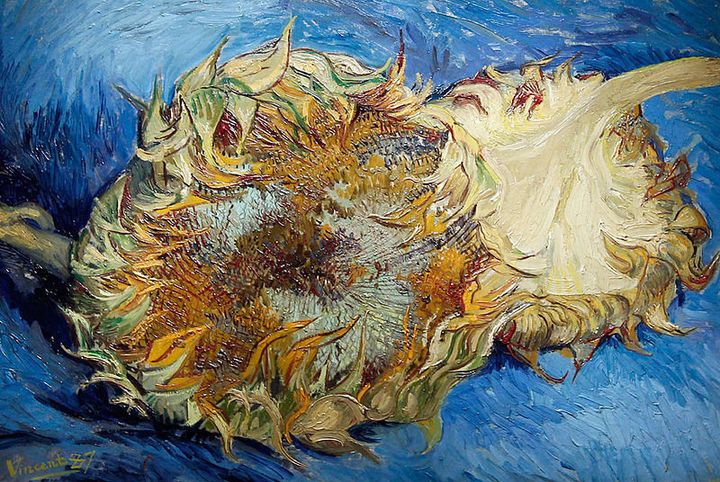
The word “sunflower” brings to mind a mane of vibrant yellow petals encircling a dark whorl of seeds. But not all sunflowers are alike. Some sunflowers have scraggly petals, for instance, or small centers. Many of the sunflowers Vincent Van Gogh depicted in his famous series of oil paintings look rather unusual, sporting wooly, chrysanthemum-like blooms. Now, scientists have pinpointed the genetic mutation responsible for these strange sunflowers’ abundance of small yellow petals.
A typical sunflower’s bloom is made of two different kinds of flowers. At the center of the sunflower’s head, disc florets nestle together in overlapping spirals. These tiny tubular, star-crowned flowers bear pollen and eventually turn into seeds. Each of the large yellow petals in the sunflower’s familiar fringe is in fact a flower all its own—sterile ray florets that have evolved to look like the petals of one giant flower. Van Gogh’s paintings from the late 1880s clearly feature some of these typical sunflowers, but they are paired with what look like fuzzy pom-poms stuck on sunflower stems.
A typical sunflower is on the left, a double-flowered variety in the middle and a tubular mutant in the third box. Arrows point out double-flowered mutants in Van Gogh's painting (Credit: John Burke, University of Georgia)
Such double-flowered sunflowers, as they are known, have overlapping rows of supple yellow petals and a small, sometimes hidden center. In a new study, John Burke of the University of Georgia and his colleagues trace the unusual floral arrangement of Van Gogh’s sunflowers to mutations of a single critical gene. The findings appear in the March 29 issue of PLos Genetics.
Van Gogh's "Vase With Fifteen Sunflowers" (Credit: Wikimedia Commons)
Burke and his colleagues worked with typical sunflowers as well as double-flowered cultivars such as the Teddy Bear sunflower, which looks like a giant dandelion. By crossing different varieties of sunflowers with one another and crossing their offspring with themselves, the researchers discovered that double-flowered cultivars have mutated forms of a gene called HaCYC2c. Usually, HaCYC2c is only turned on in ray florets. Burke found that double-flowered sunflowers turn on this gene in disc florets as well, transforming the entire sunflower head into a Koosh ball of ray florets. In mutant sunflowers, HaCYC2c seems to contain a superfluous chunk of DNA that fiddles with the gene’s on/off switch. Burke also created sunflowers in which HaCYC2c was never expressed or produced misformed proteins; in those sunflowers, ray florets did not develop properly and the whorl of seeds was fringed with unusually large, tubular disc florets.
A Teddy Bear sunflower is one of several double-flowered mutants (Credit: Wikimedia Commons)
For thousands of years, people have been growing sunflowers for their seeds, oil and beauty. The first double-flowered sunflowers probably arose naturally due to a chance mutation. Breeders likely seized the opportunity to preserve the mutants’ unique qualities and offer customers a new kind of sunflower. Apparently, Van Gogh was one such customer. But double-flowered sunflowers might not fare so well outside the kitchen vase or artist’s studio. Some double-flowered sunflowers are too sterile to reproduce properly, since ray florets bear no pollen. And at least one study suggests that losing genes in HaCYC2c’s family makes flowers less attractive to insect pollinators. Fortunately for sunflowers—even mutant ones—their future remains bright. Sunflowers have so bewitched us with their cheery dispositions that we are unlikely to stop growing them anytime soon.